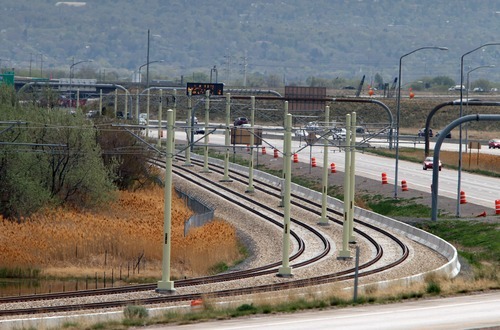This is such an interesting discussion. I remember being amazed how much of Seattle's LRT was on viaducts, but I was amazed in a good way. Grade separation all the way! Still, some parts had me perplexed. Like this part, where the ROW parallels a highway that is built on an embankment but the LRT is still on a viaduct anyway (back ground, not foreground):

In comparison, Salt Lake City built LRT parallel to a highway this way, with ballasted tracks (not expensive slab track) built directly on the ground (no viaducts).

But of course I have no information on why either method was chosen, so I will withhold judgement. All I can say is I can see where S P Hansen is coming from.
Overbuilding is not a sin when exceptional growth is expected.
As for LRT being able to climb steep grades, Bunt makes a nice point of 'can' vs 'should.' SLC has one of the steepest grades of any modern LRT alignment - on the S-curves up the hill towards the university. The rate of climb is only 7 percent, but because of the seep curves the 'compensated' grade is much worse. Because of the steep grades and tight turns, UTA had to order a modified version of Siemens S-70 LRT vehicles that are 10 feet shorter than the standard version but with the same horsepower. This gives them an exceptional power-to-weight ratio for LRT vehicles.
(Granted, the 10 feet saved per vehicle also allows UTA to run 4-car trains, but big decisions are never made for only one reason).

I have no idea how much more the steeper grades/curves cost on an operational basis. I know UTA is very careful to schedule the university trains so that the ascending and descending trains are in the same centenary zone (whatever that's really called) so that the descending train sends its regenerated power to the ascending one. They do this to cut the costs of running up the steep hill. But whether or not that offsets all the associated costs I have no idea.
And the last point of a station that may appear to be over-built... is it at lest a nice place to wait for the train? More and more transit planners are realizing that if they spend the extra money to make a station a sort of 'destination' in its own right, ridership increases as well.
Nicer Transit Stations Attract More Riders - CityLab
http://www.citylab.com/commute/2014/...e-riders/8260/
How Design Can Help Build A Transit Culture - CityLab
http://www.citylab.com/commute/2014/...-culture/8633/
Station design matters to the people who use it every day. If it doesn't enhance their day, it is probably a drain on their day. In this regard, Denver may have an advantage over my home of SLC in this category, because their Union Station really does have a sense of place. It is a 'destination station' and it will certainly attract more riders to Denver's system than 'Salt Lake Central' (an empty concrete plaza next to Amtrak's double-wide trailer station) ever will.
In fact, for the Mountain West region, I can't think of another transit hub that could rightly be called a 'destination station'.



